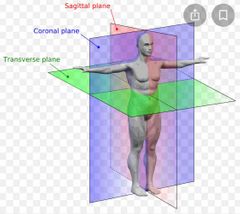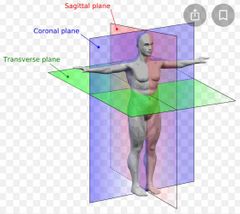![]()
![]()
![]()
Use LEFT and RIGHT arrow keys to navigate between flashcards;
Use UP and DOWN arrow keys to flip the card;
H to show hint;
A reads text to speech;
16 Cards in this Set
- Front
- Back
- 3rd side (hint)
|
Prone |
lying on your stomach |
|
|
|
Supine |
Lying on your back pronation |
|
|
|
Pronation |
1.Turn or rotate the hand or forearm with palm down.
2. Rotate foot so inner edge bears body’s weight
|
|
|
|
Supination |
1. Rotate hand or forearm so palm faces up
2. Rotate foot so that the outer edge of the sole bears the body weight |
|
|
|
Sagittal plane |
Vertical plane which passes from ventral (front) to dorsal (tear) dividing the body into right and left halves. Transverse |

|
|
|
Coronal plane |
Plane that divides the ventral and dorsal portions of the body |

|
|
|
Transverse plane |
Plane that divides the ventral and dorsal portions of the body |

|
|
|
Body Mass Index (BMI) |
A measure for human body shape based on individuals mass and height |
Mass/height |
|
|
Body Fat Percentage (BF%) |
Total mass of fat divided by total weight |
Fat/weight |
|
|
Eccentric Motion |
The lengthening of muscle fibers |
Lowering phase of an exercise |
|
|
Concentric motion |
The shortening of muscle fibers, |
Lowering phase of exercise |
|
|
Hypertrophy |
Increasing muscle size |
|
|
|
Isometric exercise |
Joint angle and muscle length do not change during the exercise |
Type of exercise where the joint angle and muscle length do not change during the exercise |
|
|
Body types |
1. Mesomorph 2. Ectomorph 3. Endomorph |
MEE |
|
|
Mesomorph |
Athletic and muscular. Can gain both muscle and fat easily. |
|
|
|
Ectomorph |
Thin framed and lean body type. |
|

